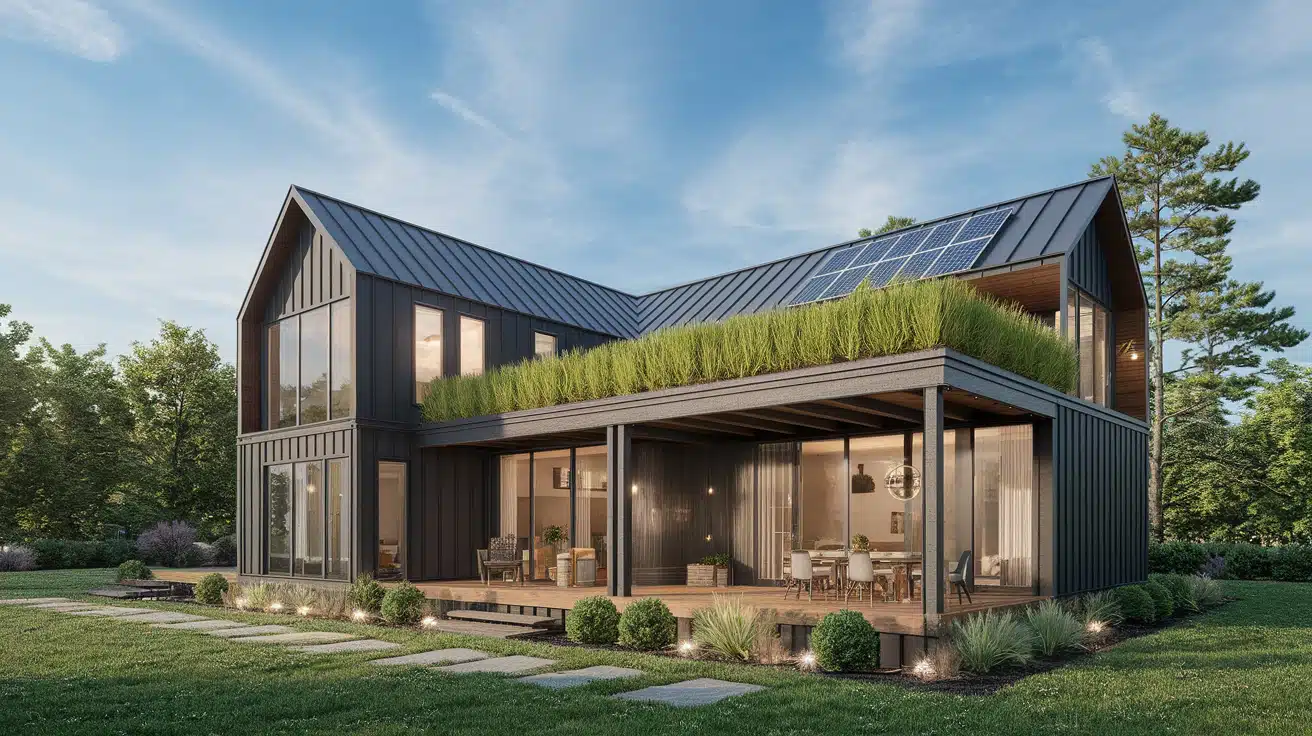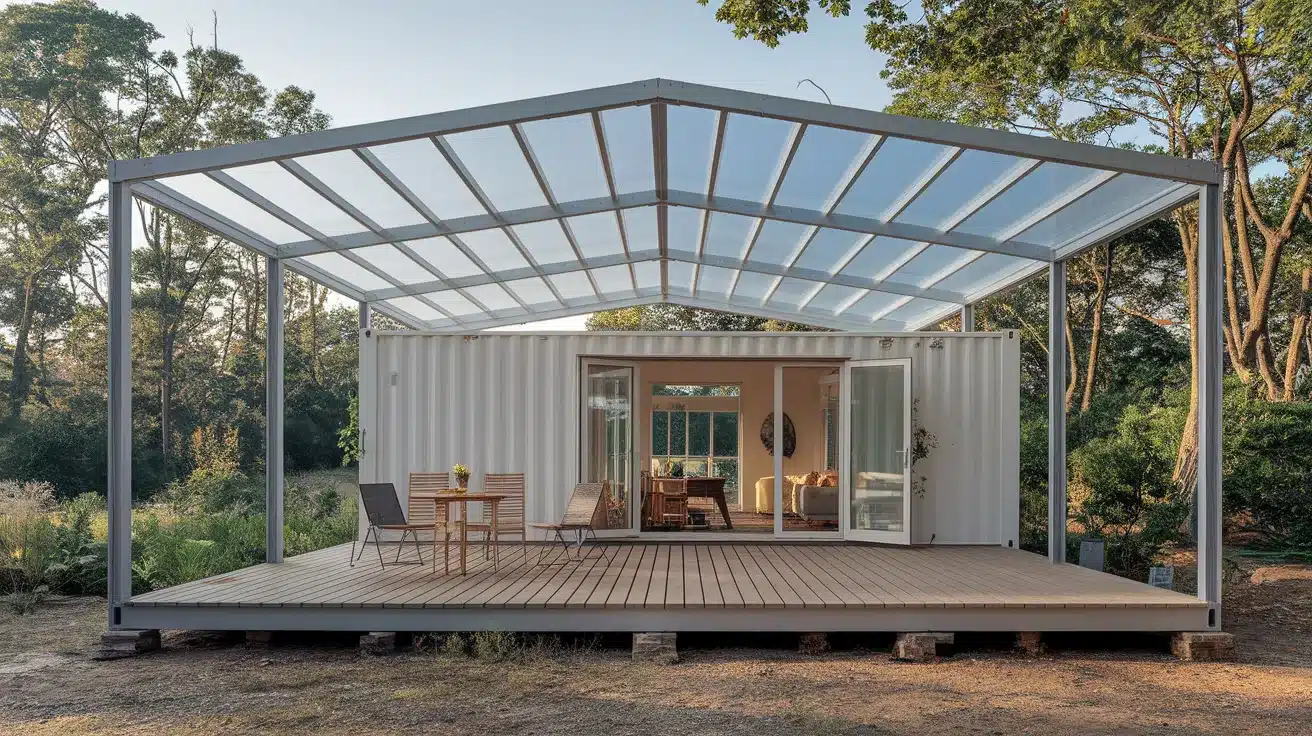Do you want a unique home that stands out? Shipping containers offer a fresh way to build. But what about the roof? That’s a key part of your comfort all year.
Many folks read online about container homes. Yet, few focus on the roof, which keeps you cozy in winter and cool in summer.
The right roof can make your container feel like a real home. It affects how well you sleep, your bills, and even your mood during bad weather.
Ready to see what’s possible? This guide shows you 9 roof styles for your shipping container. Each works in different climates and fits various budgets. By the end, you’ll know which roof will work best for your new home.
How Much Does It Cost to Put a Roof on A Shipping Container?
The cost of putting a roof on a shipping container can vary widely based on several factors, including the type of roof, the materials used, and labor costs. On average, you can expect to pay between $2,000 to $5,000 for a basic roof installation. Here’s a breakdown:
-
Flat Roof: Typically the most affordable option, costing around $2,000 to $3,000. It may include simple materials like corrugated metal or steel.
-
Gabled Roof: This is a more complex design and can range from $3,000 to $5,000, depending on the size of the container and the materials used.
-
Green Roof: The most expensive option, usually costing upwards of $5,000. This includes the cost of soil, plants, waterproofing, and structural support.
Additional costs may apply if you are including features like insulation, solar panels, or a rooftop deck. Labor costs can also influence the total cost, depending on the complexity of the installation and local rates.
9 Shipping Container Roof Ideas for Modern Home Builds
1. Green Roofs: Nature Meets Innovation
Plants and soil on container tops work as natural insulators. They keep homes cool in summer and warm in winter. These roofs catch rainwater, which cuts down water bills. They also clean the air around your home.
Green roofs last longer than normal roofs because the plants protect the surface from sun damage. You can grow flowers, herbs, or even veggies on top of your home, making good use of this extra space.
-
Best For: Eco-conscious builders looking for sustainable solutions.
-
Estimated Cost: Moderate to High.
-
Weather Resistance: Excellent for insulation and rainwater management.
2. Gabled Roof: Classic and Spacious
This roof has two sloping sides that meet at the top, making an upside-down V shape. It adds height to your container home and creates more room inside. Snow and rain run off easily, making it good for wet areas.
The shape allows for attic space or higher ceilings. You can add windows on the gable ends for more light and air flow. This style fits well with most home designs and is easy to build.
-
Best For: Homeowners seeking a traditional, open feel.
-
Estimated Cost: Moderate.
-
Weather Resistance: Good, handles snow and rain well.
3. Flat Roof with Rooftop Deck
A flat roof turns your container top into useful space. You can set up chairs, tables, and plants to create an outdoor living area. The flat design is simple to build and costs less than other styles.
It works best in places with little rain or snow. With good waterproofing, it can last many years. Add rails around the edges for safety, and you have a spot for cookouts or stargazing right on top of your home.
-
Best For: Urban dwellers wanting additional outdoor space.
-
Estimated Cost: Low to Moderate.
-
Weather Resistance: Good for dry climates; may need additional drainage in wet areas.
4. Shed Roof: Modern and Practical
This design slopes in one direction, usually from high to low. It’s simpler to build than a gabled roof and uses fewer materials. Water flows off easily in one direction, which helps with rain collection.
The higher wall can hold bigger windows, bringing in more light. The sloped design works well when joining multiple containers. Shed roofs give homes a clean, modern look while being useful and low-cost.
-
Best For: Minimalist designs with a modern edge.
-
Estimated Cost: Moderate.
-
Weather Resistance: Excellent, especially in heavy rainfall or snowy climates.
5. Corrugated Metal Roof: Durable and Long-Lasting
Metal roofs stand up to harsh weather and last for decades. The wavy pattern adds strength without extra weight. These roofs reflect sun heat, keeping your container cooler in summer.
They don’t rust or rot and can be made from reused materials. Rain makes a pleasant sound on metal, though this can be muffled with proper installation. They come in many colors to match your home’s style.
-
Best For: Those seeking durability and low maintenance.
-
Estimated Cost: Low to Moderate.
-
Weather Resistance: Excellent for extreme weather conditions (heat, rain, snow).
6. Solar Roof Panels: Harnessing the Sun’s Power
Solar panels turn your roof into a power plant for your home. They catch sunlight and change it into electricity for your needs. Over time, they pay for themselves through lower power bills.
Modern panels are thinner and better-looking than older models. They work even on cloudy days, though not at full power. You can start small and add more panels later as your budget allows.
-
Best For: Sustainable and energy-efficient homes.
-
Estimated Cost: High initial investment but long-term savings.
-
Weather Resistance: Great for sunny climates; protects against harsh weather.
7. Insulated Roofs: Keep Your Space Comfortable Year-Round
These roofs have special layers that stop heat from moving in or out. They keep warm air inside during winter and hot air outside during summer. This cuts down on heating and cooling costs.
The insulation also blocks sound, making your home quieter. Materials like foam, fiber, or reflective barriers can be used. The right choice depends on your local weather and your budget.
-
Best For: Cold or hot climates where insulation is key.
-
Estimated Cost: Moderate to High.
-
Weather Resistance: Excellent for both cold and hot climates.
8. Transparent Roof: Natural Light All Year
Clear panels made of strong plastic or glass let sunlight into your container home. This brings free light during the day and lets you see the stars at night. Modern materials block harmful sun rays while letting in light.
They can be as strong as regular roofing and often have good insulation value. You can use them for the whole roof or just in certain spots for a sunroof effect.
-
Best For: Those who want a bright and airy interior.
-
Estimated Cost: Moderate.
-
Weather Resistance: Good, but needs UV protection.
9. Arched Roof: Unique and Efficient
The curved shape of an arched roof helps it carry weight better than flat designs. Snow, rain, and wind flow around it rather than pushing down. This style turns your container’s flat top into an eye-catching feature.
The curve creates more head room inside without needing to build up walls. While a bit harder to make, these roofs use fewer supports and can span longer distances.
-
Best For: People looking for a distinctive architectural feature.
-
Estimated Cost: High.
-
Weather Resistance: Excellent for heavy rainfall and snow.
Downside of Container Homes
While container homes offer many benefits, such as affordability, sustainability, and flexibility, there are a few downsides to consider:
-
Insulation and Temperature Control: Shipping containers are made of steel, which can make them prone to extreme temperature fluctuations. In cold climates, they can be difficult to insulate effectively, and in hot climates, they may get uncomfortably warm without proper ventilation and cooling systems.
-
Rust and Corrosion: Over time, exposure to the elements can cause shipping containers to rust, especially if they’re not properly maintained or treated with anti-corrosion coatings. This can reduce their lifespan and structural integrity.
-
Space Limitations: While containers are modular and stackable, their narrow width (typically 8 feet) can feel cramped for larger families or those seeking more spacious interiors. Customizations can be made, but space is still limited compared to traditional homes.
-
Zoning and Building Codes: Depending on your location, you may face zoning restrictions and building code challenges when using shipping containers as homes. Some areas may have strict regulations regarding their use, making it harder to build a container home legally.
-
Resale Value: Shipping container homes might not appeal to everyone, and in some areas, they may have lower resale value compared to traditional homes. The uniqueness of a container home can be a selling point, but it could also limit potential buyers.
-
Construction Costs and Complexity: While the containers themselves can be affordable, the cost of retrofitting, adding insulation, and making them livable can add up quickly. Depending on the design, construction might require specialized labor and materials, increasing the overall cost.
While container homes can be a sustainable and innovative housing option, it’s important to carefully weigh these potential downsides before making a decision.
Conclusion
Looking back at our roof options, you now have several paths for your container home. Each roof type offers different benefits for weather protection, style, and cost.
Remember that your local climate plays a key role in your choice. A green roof works well in mild weather, while corrugated metal stands up to extreme conditions.
So what’s next? Start by checking local building codes. Then, look at your budget and climate needs. Consider talking with contractors who have worked on container homes before.
Ready to make your container truly livable? The right roof transforms a simple metal box into a comfortable home for years to come. Share your roof plans in the comments below, or ask questions about your specific situation.
Frequently Asked Questions
What Kind of Roof Do You Need for A Shipping Container?
You’ll need a sloped or flat roof, depending on the container’s use. A sloped roof helps with water drainage, while a flat roof is suitable for additional storage or solar panel installation.
How Much Weight Can You Put on Top of A 20ft Container?
A 20ft shipping container can typically support up to 60,000 pounds (27,000 kg) on top, but this can vary depending on the container’s condition and the load distribution.
Why Do Container Homes Only Last 25 Years?
Container homes generally last about 25 years due to exposure to the elements, corrosion from moisture, and wear on the structure over time, especially if not properly maintained.
Does Mold Grow in Shipping Containers?
Yes, mold can grow in shipping containers if they are not properly ventilated and are exposed to moisture or humidity for extended periods. Proper insulation and ventilation can help prevent mold growth.

















